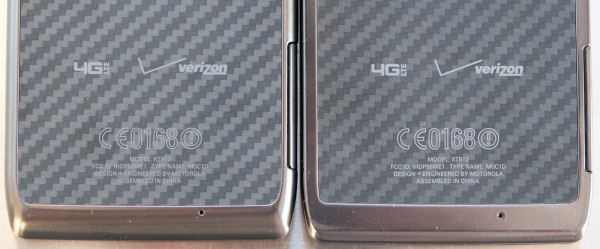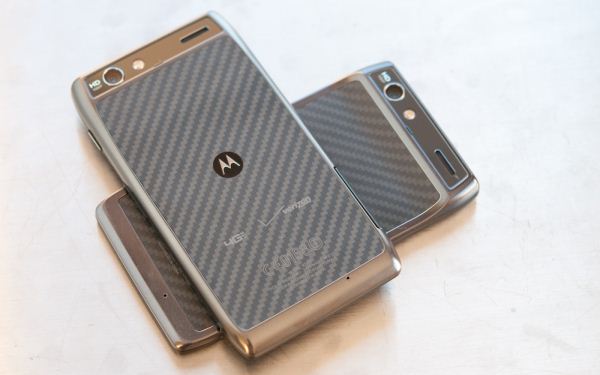
Original Link: https://www.anandtech.com/show/5533/motorola-droid-razr-maxx-review-18x-the-battery
Motorola Droid RAZR MAXX Review - 1.8x The Battery
by Brian Klug on February 14, 2012 2:01 PM EST- Posted in
- Smartphones
- Motorola
- Android
- Mobile
- motorola droid RAZR
- RAZR MAXX
- RAZR
Motorola Droid RAZR MAXX Review
For a while now, our chief complaint when talking about 4G LTE handsets has been battery life. The combination of 45nm cellular basebands, ever increasing screen size, and 4x nm SoCs has been unforgiving in the power department. Handset manufacturers are always engaged in a difficult balancing act between device size, price, and the resulting battery life. Too big of a battery and you’ve created a brick that looks unattractive next to other svelte phones, too small and you’ve created something that looks great but needs to be tethered to the wall all day.
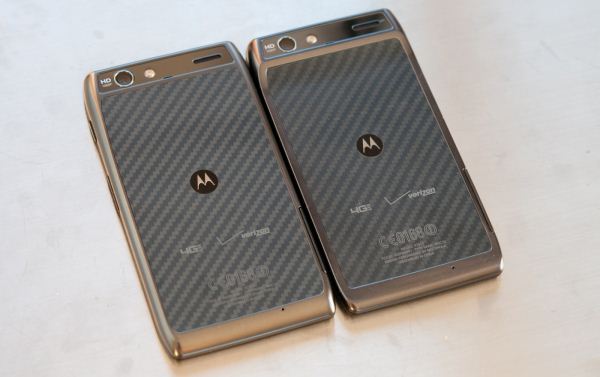
Droid RAZR MAXX (left), Droid RAZR (right)
We’ve already reviewed the Motorola Droid RAZR, which itself is a close cousin of the Motorola Droid Bionic. As a result, we’re not going to go into super depth with the MAXX since it would be a 1:1 repeat in basically every part to what we talked about in the RAZR review already. The RAZR MAXX and RAZR are quite literally the exact same device (PCB, display, cellular basebands, camera, etc.) with the exception of battery and exterior case.
The two share the same model number (XT912), FCC-ID (IHDP56ME1), and run the same software. Motorola has talked about reducing the number of devices released yearly and consolidating down to just a few flagships, and though it’s easy to claim otherwise, the RAZR and RAZR MAXX don’t really confuse things that much since, again, they’re really the same phone with a different case and battery. The result of that similarity is that from a software and carrier testing perspective, delivering updates to one means delivering updates to the other, something we’ve already seen turn out to be the case with the recent 6.12.173 update.
What’s changed with the MAXX incantation is its battery, which is significantly larger. It seems as though Motorola has been feeling nostalgic about some of its old brands lately, reviving first the RAZR brand, and now the “MAXX” brand in the form of a moniker (anyone else remember the MOTORAZR MAXX?). In this case, what’s MAXX about the RAZR MAXX is its battery, which is 1.88 times the size of the RAZR battery. (As an aside, I can’t help but think of the Rage Fury MAXX every time I type MAXX)
The MAXX also continues use of Motorola’s higher voltage Li-ion chemistry, which is 3.8V nominal as opposed to the standard 3.7V nominal voltage. Motorola continues to use this higher voltage chemistry on a majority of its new devices. As I talked about in the Bionic and RAZR reviews, this means you can’t directly compare mAh, instead watt-hours is better for comparison purposes here. We’ve been careful about using Whr, and I only think in Whr anymore, which finally paid off with this jump to a higher voltage.
| LTE Smartphone Battery Size Comparison | ||||||
| HTC Rezound | CDMA/LTE Galaxy Nexus | Motorola Droid RAZR | Motorola Droid RAZR MAXX | |||
| Nominal Voltage | 3.7 V | 3.7 V | 3.8 V | 3.8 V | ||
| Capacity in mAh | 1620 mAh | 1800 mAh | 1750 mAh | 3300 mAh | ||
| Capacity in Watt-Hours | 5.99 Whr | 6.66 Whr | 6.65 Whr | 12.54 Whr | ||
Against the competition, the RAZR MAXX battery is positively huge, and is larger than the Bionic’s extended battery which itself was a hefty 10.2 Whr. The battery remains sealed inside and not easily replaceable, but given its size this is a totally acceptable trade-off. That’s really where the MAXX makes sense - if you’re going to sacrifice battery access and replaceability, it should be absolutely beyond a doubt big enough to make it through at least one day’s worth of constant abuse.
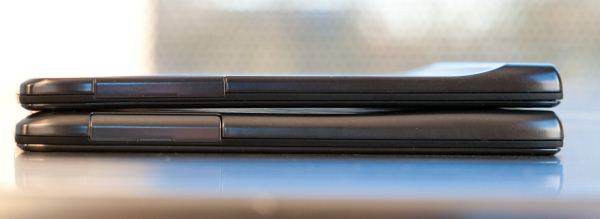
RAZR MAXX (bottom), RAZR (top)
The MAXX does put on some weight and get heftier in the midsection as a result, but the phone is still remarkably thin. What’s interesting is that although the RAZR MAXX is thicker than the RAZR at its thinnest point, the two phones’ thickest points are still the same. I guess that really illustrates what’s wrong with the way that OEMs are specifying device “thickness” these days more than anything, as most intentionally cite the device thickness at its thinnest point. One other OEM has told me it’s going to move to a mean thickness measurement, which seems to be more representative but potentially complicated. Personally, giving min and max seems to be the most honest disclosure, and again on the MAXX only the thinnest point gets thicker. Mass goes up 17 grams, just 13% over the RAZR.
| Physical Comparison | ||||
| Apple iPhone 4S | Samsung Galaxy Nexus (LTE) | Motorola Droid RAZR | Motorola Droid RAZR MAXX | |
| Height | 115.2 mm (4.5") | 135.5 mm (5.33") | 130.7 mm (5.15") | 130.7 mm (5.15") |
| Width | 58.6 mm (2.31") | 67.94 mm (2.67) | 68.9 mm (2.71") | 68.9 mm (2.71") |
| Depth | 9.3 mm ( 0.37") | 9.47 mm (0.37") | 7.1 mm (0.28") | 8.99 mm (0.35") |
| Weight | 140 g (4.9 oz) | 150 g (5.3 oz) | 127 g (4.5 oz) | 145 g (5.1 oz) |
| CPU | Apple A5 @ ~800MHz Dual Core Cortex A9 | 1.2 GHz Dual Core Cortex-A9 OMAP 4460 | 1.2 GHz Dual Core Cortex-A9 OMAP 4430 | 1.2 GHz Dual Core Cortex-A9 OMAP 4430 |
| GPU | PowerVR SGX 543MP2 | PowerVR SGX 540 | PowerVR SGX 540 | PowerVR SGX 540 |
| RAM | 512MB LPDDR2-800 | 1 GB LPDDR2 | 1 GB LPDDR2 | 1 GB LPDDR2 |
| NAND | 16GB, 32GB or 64GB integrated | 32 GB NAND | 16 GB NAND, 16 GB microSD class 4 preinstalled | 16 GB NAND, 16 GB microSD class 4 preinstalled |
| Camera | 8 MP with LED Flash + Front Facing Camera | 5 MP with AF/LED Flash, 1080p30 video recording, 1.3 MP front facing | 8 MP with AF/LED Flash, 1080p30 video recording, 1.3 MP front facing | 8 MP with AF/LED Flash, 1080p30 video recording, 1.3 MP front facing |
| Screen | 3.5" 640 x 960 LED backlit LCD | 4.65" 1280x720 SAMOLED HD | 4.3" 960 x 540 SAMOLED Adv. | 4.3" 960 x 540 SAMOLED Adv. |
| Battery | Internal 5.3 Whr | Removable 6.85 Whr | Internal 6.65 Whr | Internal 12.54 Whr |
In the hand, I find the MAXX to unsurprisingly feel very similar to the RAZR. The thickness change is obviously perceptible, but not a big deal. The RAZR remains a thin, flat device, and adding 2 mm at the thinnest point honestly doesn’t change the way that things feel to me. In the pocket, I think you’d have a hard time feeling the difference between the RAZR and the RAZR MAXX - neither print very much in a pair of jeans or dress slacks.
Interestingly enough the most notable change between the RAZR and the RAZR MAXX is that the two don’t lie flat the same way back down on a table. The RAZR tilts slightly thanks to that thickness difference, the RAZR MAXX is very close to being completely coplanar with the surface it’s resting on. The backside still has the slightly rubberized Kevlar material, though the curve at the top isn’t nearly as small. The microSD and microSIM door at the side gets a bit taller as well.
The RAZR MAXX is probably the first time I’ve seen a device offer a significantly larger battery without it being an obvious afterthought. The traditional extended battery upgrade path usually involves getting a new battery door with a huge, obvious, awkward bulge. Almost every single time, that battery door either doesn’t match or fit properly, or it’s just an awkward afterthought. The other upgrade option is usually a battery with the same volume but slightly more capacity. The MAXX is neither - a device with a notably bigger battery that doesn’t make all the concessions that normally accompany such an upgrade.
Battery Life
Obviously the most important thing with this kind of upgrade is seeing just what kind of use time you can get out of a device with a relatively gargantuan 12.5 Whr battery, and for this we turned to our battery life testing suite. I investigated the Bionic’s extended battery back in its own review, and these increases in battery size almost always reflect (unsurprisingly) almost a perfect linear scaling.
When I started this review, the RAZR MAXX was running the original software release just before the 6.12.173 update which we briefly discussed in a pipeline post. This update adds connected discontinuous reception (cDRX) support to the RAZR MAXX’s ‘Wrigley’ LTE baseband, which improves battery life. That said I’m told only markets with Ericsson as the supplier have been updated, and I’m in an Alcatel-Lucent Verizon area. The point is that battery life really can only get better from the numbers below, and if you’re lucky enough to be in one of those markets, you’ll enjoy the benefits with the latest update. In addition, I also discovered that our RAZR review unit was running a weird build of software, 6.11.777, which I’ve since managed to get running 6.12.173 just like the MAXX, though most of these tests reflect the 6.11.777 numbers we initially obtained. If you’ve been watching bench as I’ve added numbers, this is why things sometimes change around until the review posts as I run and re-run tests. While finishing this review I’ve obtained an HTC Rezound and Droid 4 which we’re working on reviewing as well - these battery life results are included in here where available as well.
Anyhow, onto the results. The tests haven’t changed since we’ve talked about them last, and first up is the call test which consists of a call placed between the phone under test and another line, with music played a both ends at medium volume to avoid saturation.
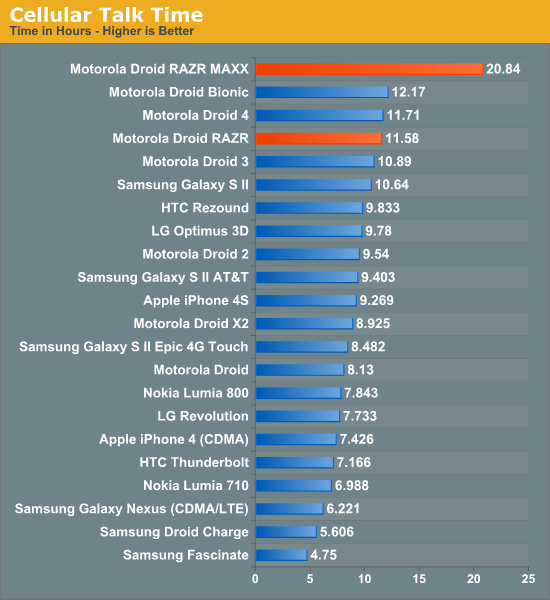
Unsurprisingly we see an almost perfect 1.8x scaling here and get very close to the expected 21 hours of battery life you’d expect. The RAZR MAXX lasts astoundingly long if you’re interested in just voice calls, and Motorola continues to dominate the CDMA2000 1x voice tests. On 4G LTE handsets this is with the phone left in “CDMA/LTE” mode, though the LTE baseband is in RRC_IDLE state and consuming almost no power, while the MDM6600 handles the 1x voice call. As an aside, we’re almost getting to the point where voice battery life is so long that running this test is almost unweildy.
Next up are the web browsing tests, on 3G EVDO, 4G LTE, and WiFi. Here we load through a couple dozen pages with the display set to exactly 200 nits until the phone dies. We’re going to update this pretty soon with some more cache-busting features, but for now it does demonstrate that nice scaling for the most part.
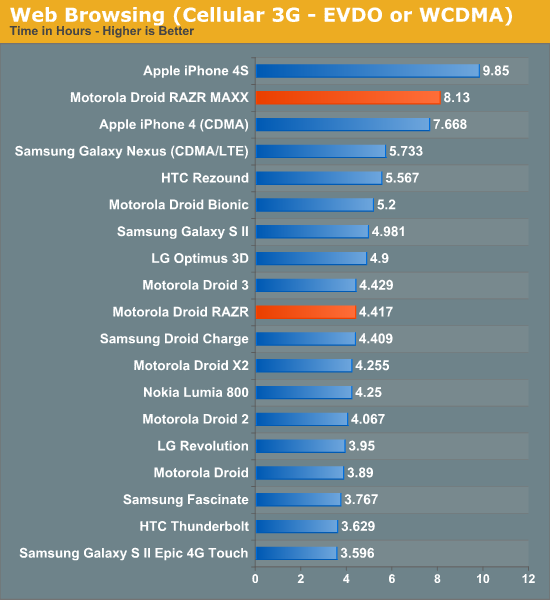
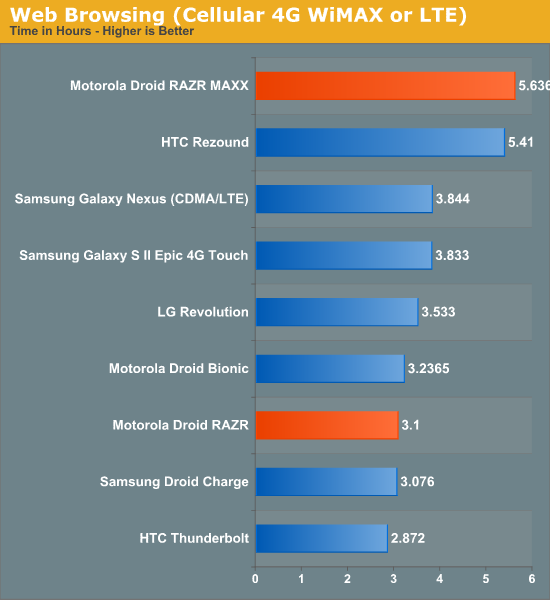
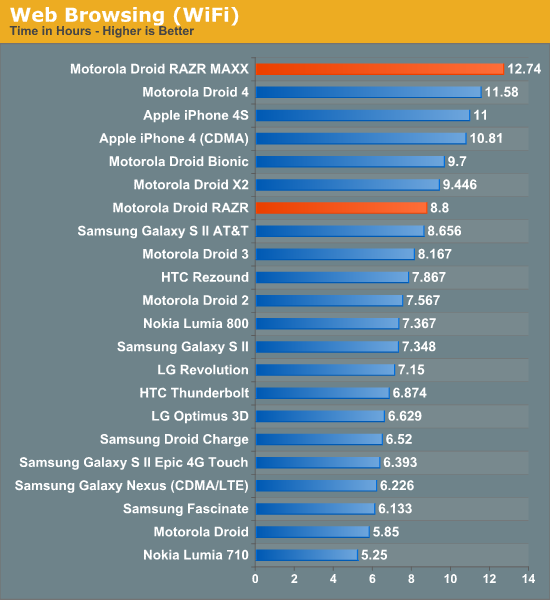
In both the 3G and 4G tests, we see very close to the expected scaling, and the RAZR MAXX easily captures the top spot among Android phones. The only phone close to the RAZR MAXX at basically any point is the HTC Rezound in this test, which surprised me with its LTE battery life. On EVDO the RAZR MAXX is pretty much top dog among the Android crowd, and also good enough to place among the iPhone 4 and 4S. Only in the WiFi web browsing test does the MAXX slip just short of the expected 1.8x scaling, but still posts an impressive result.
Finally we’ve got our hotspot battery life tests, which consist of four tabs of our page tests and a 128 kbps MP3 streaming radio session being loaded on one client laptop and a WPA2 PSK. I had some issues with the hotspot stability on the original RAZR software, and had to resort to running that initial test with WPA2 turned off. I’ve repeated these tests and now have better numbers.
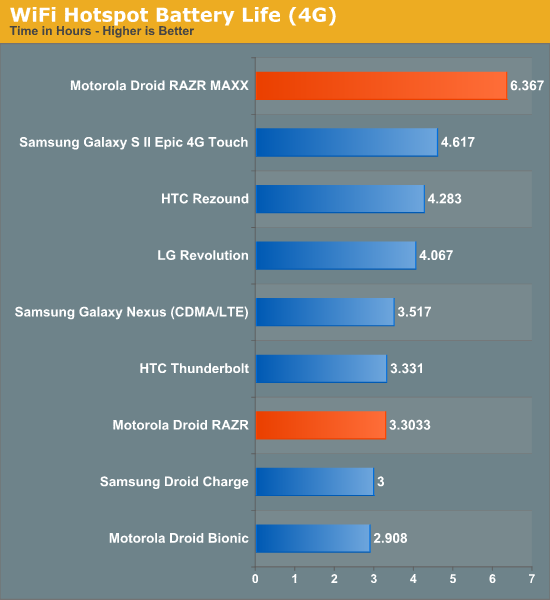
The hotspot test is great since it’s the only place other than the call test where we can isolate out the display (which ends up being by far the dominant factor) and gauge power draw from the combination of SoC, cellular baseband, RF, and WLAN. Here you can see the RAZR MAXX performs as expected and pretty much blows away everything else - other devices like the Rezound might get better battery life with the display on from using LCD (as opposed to AMOLED), but you can’t get around having more watt-hours to draw from.
So what do all these tests translate to in real world day to day use? Well, like anything the answer depends on your workload. If you use the phone as a hotspot while playing GTA III, obviously you’re going to still kill the phone in a few hours. If you’re just using it to occasionally poll twitter, check email, and reply to a few text messages, battery life on the order of two days isn’t hard to imagine. It’s hard to assign a realistic number given just how varied everyone’s use patterns are.
| Charging Time Comparison | ||||||
| Motorola Droid RAZR | Motorola Droid RAZR MAXX | |||||
| Charge time from 0% to 100% | 3.083 hours | 4.217 hours | ||||
I also tested how long the RAZR MAXX takes to charge fully after being completely, absolutely bone dry empty. On the MAXX that comes to 4.217 hours using the Motorola supplied 750 mA charger, which isn’t bad at all. The MAXX battery capacity isn’t so large that you can’t charge it on a nightstand and expect it to be 100% in the morning. I also timed the normal RAZR which came to just over 3 hours. I expected the MAXX to take much longer to charge, but the reason is no doubt the fact that Li-Ion battery charge curves aren't linear at all.
Since the RAZR Review
The Droid RAZR and RAZR MAXX as of this writing have been both pushed the same “6.12.173.XT912.Verizon.en.US” update, which makes a number of changes and improvements that mitigate some of the things I complained about in the initial Droid RAZR review. The core Android version is now 2.3.6. I’ve re-run our performance tests, and nothing has really changed here, unsurprisingly.
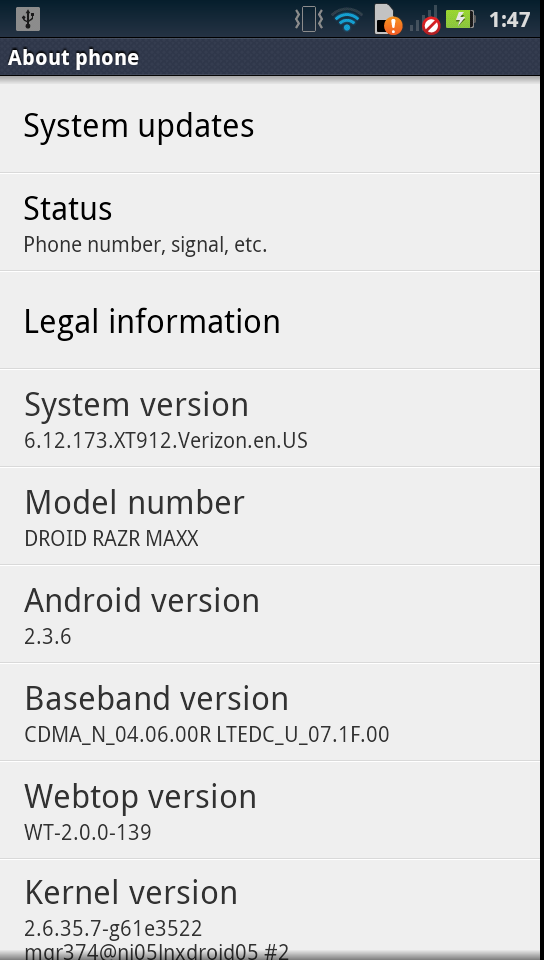
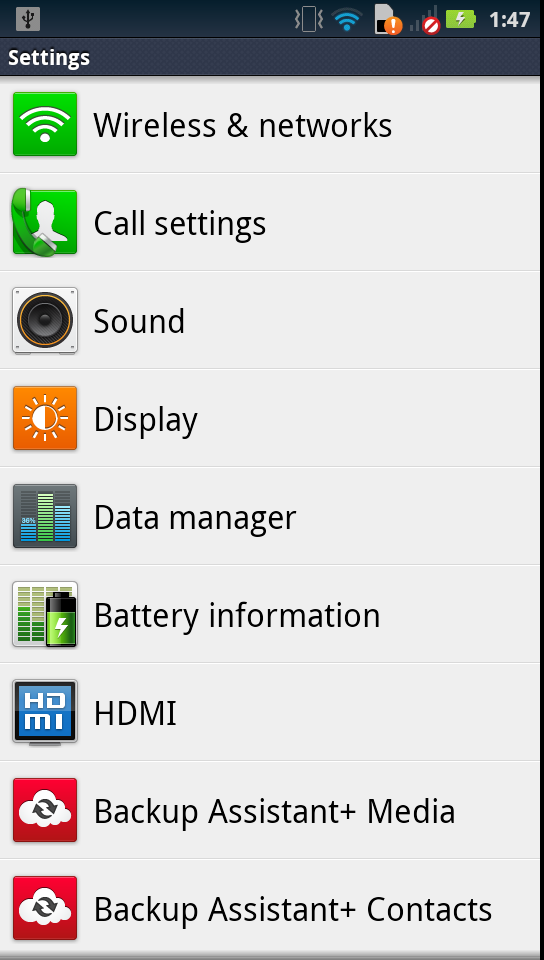
First, the update changes the Settings page aesthetics slightly, including some icons that weren’t there previously. There’s also a change to some of the other icons on the home screen, and the cDRX features I’ve written about before.
I noted some frustration with the RAZR’s camera app in the original review, this has been significantly improved in the latest update. Stability is much improved, UI items no longer completely disappear and the camera app hasn’t crashed at all. In addition I no longer see the RAZR miss focus entirely like I did before, which was a big problem at times.
GNSS
Some other OEMs have written about GLONASS support on their hardware, and I forgot to note in the initial RAZR review that this device also includes GNSS (GPS+GLONASS) support the same way courtesy the MDM6600. Until recently basically all satellite based location has used GPS, which consists of a constellation of 27 satellites. GLONASS is its Russian cousin, with 24 satellites. The two can be used in conjunction to get faster 3D fixes, better coverage, and greater accuracy. We'll see more and more GNSS solutions start shipping in 2012 as well.
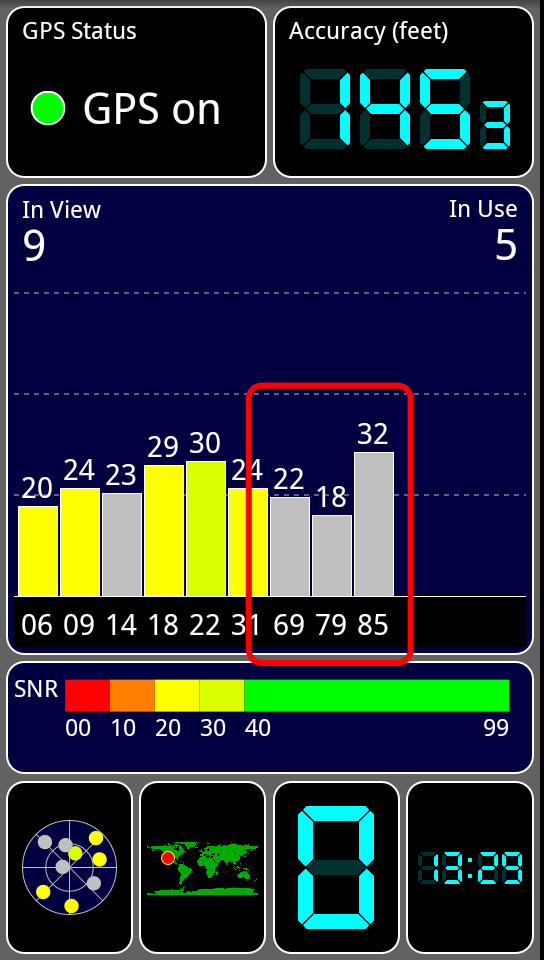
GLONASS satellites are used here, circled in red
If you fire up GPS Test, satellites numbered 65-88 are GLONASS. Qualcomm’s GNSS only uses GLONASS when there either aren’t enough visible GPS satellites for a fix, or SNR is bad (basically an urban canyon or indoors scenario), so you’ll often see a set of bars pop in or out depending on how good the normal GPS SNR is. This implementation is the same for all of the Qualcomm SoCs and MDMs that include GNSS support.
Final Words
If you want a smartphone that’s uncompromising about battery life and also includes 4G LTE connectivity, the Droid RAZR MAXX is a no brainer, especially over the Droid RAZR sans MAXX. There’s just no other device out there right now that lasts as long and isn't a feature phone or crippled in some way, and in a world where everything is being fabbed on a 4x nm process, battery life at the high end is entirely a function of battery capacity. Until 28nm SoCs and basebands start arriving in devices later this year, things aren’t going to change much, either - you just need a big battery to post the kind of numbers the MAXX does in our battery life tests.
The RAZR MAXX is a device after my own heart, as I almost always end up buying or seeking out whatever extended battery option is available for whatever device I carry. There’s just nothing more frustrating than constantly worrying about having a dead device with no charger in sight. On trips and visits to cafes with intermittent or barely working WiFi, hotspot battery life ends up being probably the most important thing to me, and remains the big battery life equalizer.
Right now on Verizon the top tier of Android phones in my mind really is a two horse race. On one side is the Galaxy Nexus which is awesome purely because it’s running Android 4.0 with no customizations. On the other hand, the RAZR MAXX is a device with very similar specifications (and the same CPU, GPU, and clocks), but with a much larger battery. That's a big simplification, but superficially those are the biggest factors. As soon as the RAZR MAXX gets its Android 4.0 update, I think it’ll be hard to argue in favor of the Galaxy Nexus over the MAXX for most customers, though the former will continue to be the platform that gets updates first, comes with an unlocked bootloader, making it the obvious enthusiast choice. For people who don't find themselves presented with a charger at the end of every day, or can't charge the device on a regular schedule, the MAXX is also a no-brainer.
If anything, I hope that the RAZR MAXX sets a new trend for devices with internal batteries, which a lot of recent devices have started shipping with. If you’re going to make a device and seal the battery inside, at least make it huge.

